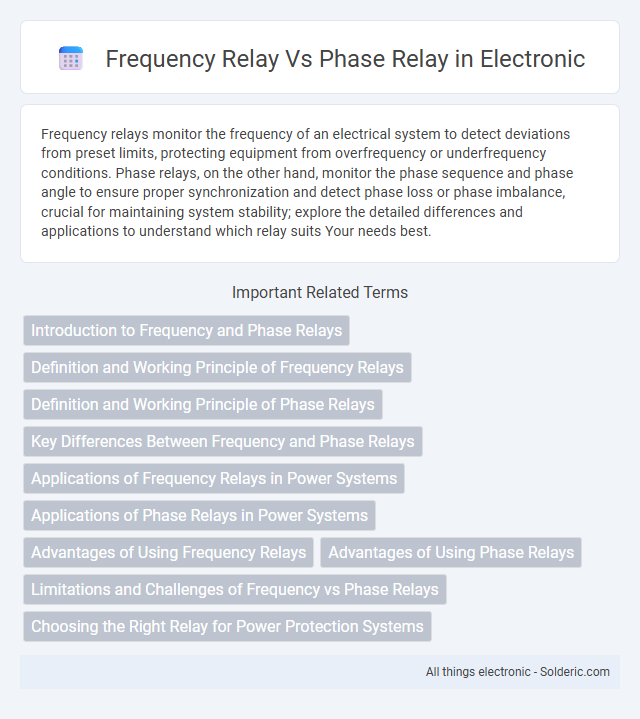Frequency relays monitor the frequency of an electrical system to detect deviations from preset limits, protecting equipment from overfrequency or underfrequency conditions. Phase relays, on the other hand, monitor the phase sequence and phase angle to ensure proper synchronization and detect phase loss or phase imbalance, crucial for maintaining system stability; explore the detailed differences and applications to understand which relay suits Your needs best.
Comparison Table
| Feature | Frequency Relay | Phase Relay |
|---|---|---|
| Primary Function | Monitors and controls system frequency | Detects phase presence, sequence, and phase loss |
| Application | Protects generators, motors, and power grids from frequency deviations | Protects equipment from phase unbalance, phase loss, and incorrect phase sequence |
| Operation Principle | Triggers on predefined frequency threshold (over/under frequency) | Operates based on phase voltage/current presence and phase rotation |
| Typical Usage | Grid frequency control, load shedding, generator protection | Motor protection, phase sequence monitoring, phase failure detection |
| Response Time | Fast, depending on frequency deviation measurement | Immediate reaction upon phase detection abnormalities |
| Output | Relay trip or alarm signal on frequency violation | Relay output to disconnect or alarm on phase issues |
| Examples | Over-frequency relay, Under-frequency relay | Phase failure relay, Phase sequence relay |
Introduction to Frequency and Phase Relays
Frequency relays monitor and control the frequency of electrical power systems, ensuring stability by detecting deviations from preset frequency thresholds. Phase relays detect phase angle differences between electrical signals, providing protection against phase imbalances and faults in three-phase systems. Both relays play critical roles in maintaining grid reliability by responding to distinct electrical parameters essential for system integrity.
Definition and Working Principle of Frequency Relays
Frequency relays monitor electrical system frequency to detect deviations from preset values, protecting equipment from damage caused by overfrequency or underfrequency conditions. These relays operate by comparing the input signal frequency against set thresholds, triggering an alarm or disconnection when the frequency deviates beyond acceptable limits. Understanding the working principle of frequency relays ensures your electrical system maintains stability and prevents faults due to frequency anomalies.
Definition and Working Principle of Phase Relays
Phase relays detect phase imbalances or missing phases in three-phase electrical systems by monitoring the voltage or current difference between phases, ensuring protection against phase failure or phase sequence errors. They operate by comparing phase voltages or currents using electromagnetic or solid-state components to trigger a trip signal when deviation from preset thresholds occurs. This precise detection helps prevent damage to motors and other equipment caused by phase loss or incorrect phase rotation, maintaining system reliability.
Key Differences Between Frequency and Phase Relays
Frequency relays monitor and respond to deviations in electrical system frequency, ensuring stability by detecting over-frequency or under-frequency conditions, while phase relays focus on monitoring the phase angle differences or phase sequence to protect equipment from phase loss, phase reversal, or unbalanced conditions. Frequency relays are critical in applications involving load shedding and generator synchronization, whereas phase relays are essential in motor protection and detecting incorrect connections in three-phase systems. The key differences lie in their operational parameters--frequency relays measure Hertz values, and phase relays assess phase discrepancy and rotation direction.
Applications of Frequency Relays in Power Systems
Frequency relays play a crucial role in power systems by monitoring and detecting abnormal frequency deviations that can indicate system instability or faults. They are widely used for load shedding, generator protection, and maintaining grid reliability during under-frequency or over-frequency events. Your power system benefits from frequency relays by ensuring prompt corrective actions, preventing equipment damage, and enhancing overall system resilience.
Applications of Phase Relays in Power Systems
Phase relays are essential in power systems for detecting phase imbalances, phase sequence errors, and phase loss conditions, ensuring the protection of motors and transformers from damage due to incorrect phase conditions. They are widely used in applications such as motor protection, phase failure detection, and synchronization of generators to prevent phase mismatch and equipment failure. Phase relays maintain system stability and reliability by continuously monitoring the phase angles and preventing unsafe operating conditions.
Advantages of Using Frequency Relays
Frequency relays provide precise monitoring and control of power system frequency, enhancing grid stability and protecting equipment from abnormal frequency conditions. They offer rapid detection of frequency deviations, enabling swift corrective actions to prevent system failures or blackouts. Unlike phase relays, frequency relays are less sensitive to phase angle variations, ensuring reliable operation in dynamic electrical environments.
Advantages of Using Phase Relays
Phase relays offer precise detection of phase loss, phase sequence, and phase imbalance, enhancing protection for three-phase electrical systems. Their ability to quickly identify abnormal phase conditions reduces the risk of motor damage and system downtime compared to frequency relays, which primarily monitor system frequency. Phase relays are particularly advantageous in industrial applications requiring reliable phase monitoring to ensure operational stability and equipment longevity.
Limitations and Challenges of Frequency vs Phase Relays
Frequency relays face limitations such as slower response times and sensitivity to load variations, which can cause unreliable tripping during transient frequency fluctuations. Phase relays often struggle with issues like phase angle detection accuracy and susceptibility to harmonics, leading to false trips or failures in complex power systems. Your protection scheme must carefully address these challenges by selecting the relay type that aligns with system stability and fault detection requirements.
Choosing the Right Relay for Power Protection Systems
Choosing the right relay for power protection systems depends on the specific electrical parameters you need to monitor. Frequency relays protect equipment by detecting abnormal frequency deviations, ensuring stable power system operation, while phase relays monitor phase sequence and phase loss to prevent damage from incorrect or unbalanced phases. Understanding your system's requirements will help you select the relay that optimizes protection and maintains power reliability.
Frequency relay vs phase relay Infographic

 solderic.com
solderic.com